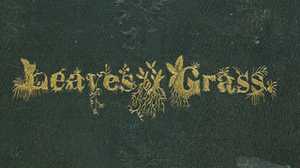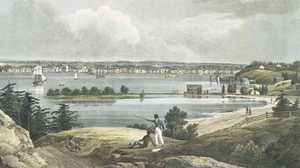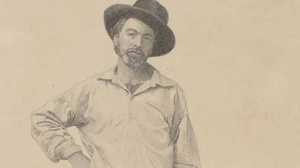Walt Whitman: Teacher's Guide
Walt Whitman offers insights into social studies topics including the Civil War, the impact of war on soldiers and their families, American literary history, the history of New York City, the role of creative expression in response to political and military events, and more. Use the program in your classroom, or delve into the rich resources available on this Web site.

Comprehension:
The following description of Walt Whitman's life contains 15 inaccuracies.
Use information from his briography page, timeline and the film to find all 15. Then rewrite the passage on a sheet of paper, correcting the mistakes and underlining the words you changed.
Walt Whitman was born in New York City in 1819. As a teenager he worked for several newspapers in and around New York; he also worked as a schoolteacher and a printer. In 1848 he moved to New Orleans to write poetry. Later that year he returned to Brooklyn and founded a pro-slavery newspaper. His book of poetry, Leaf of Grass, appeared in 1855. It was unique both in its subjects, such as the body and the self, and its elaborate rhymes. Ralph Waldo Emerson, the leading literary figure of the era, praised Whitman highly, as did many other reviewers. Whitman published a new edition of the book in 1860 containing poems that he hoped would help prevent the Mexican War.
When war came anyway in 1862, Whitman encountered wounded soldiers after visiting a battlefield in search of his brother, who was in the Confederate Army. He spent considerable time during the war visiting army hospitals in Washington, DC to comfort the soldiers. Several times he also saw President Lincoln, whom he strongly disliked. When Lincoln was assassinated shortly before the war's end in 1865, Whitman wrote a poem honoring him, "When Lilacs Last in the Dooryard Bloom'd."
After the war, no more editions of Leaf of Grass were published during Whitman's lifetime. His health began declining in the 1880s, and in 1892 he died. His book of poems sells almost as many copies each year today as it did when it was first published.
Activities:
Whitman's unique voice.
Whitman's poems contrast sharply with those of other poets of the era. To see just how sharply, divide the class into six groups and assign each group one of the following poets: Emily Dickenson, Ralph Waldo Emerson, Henry Wadsworth Longfellow, James Russell Lowell, Edgar Allen Poe, and John Greenleaf Whittier.
Have each group prepare an oral presentation for the class that includes (a) a brief biography of their assigned poet and (b) a reading of one of his or her best-known poems. Groups should also copy the poem onto poster-sized paper and post it on the wall.
After all of the groups have made their presentations, have a volunteer read aloud the opening of Whitman's Leaves of Grass. Then discuss as a class: What is your first impression upon hearing Whitman's poem after the others? Is Whitman unique because of how he wrote, what he wrote about, or both? Which of the six other poets you learned about most resembles Whitman? Which least resembles Whitman?
Today's national artist?
As commentators have noted, Whitman saw himself as a national poet -- someone whose writings would help address the most serious issues of his era, such as the divisions the United States faced that led to Civil War.
Hold a class discussion on what you believe are the most serious issues the United States faces today. (These issues can be political, environmental, spiritual, economic, social, and so on.) Then, on your own, think of an artist -- writer, musician, painter, etc. -- whom you believe is addressing one or more of those issues in a constructive and important way and thus could be called a "national artist." Have each student tell the class why he or she chose that person, and if possible, provide an example of the artist's work. List the "nominees" on the board and vote to see which person the class favors.
Daily life in Whitman's "Manhatta."
Take a tour of New York in Whitman's era, and learn about the many changes it was experiencing. As you do, note one or more of the topics discussed there that you would like to know more about. Share your ideas with the rest of the class, and use these ideas to create a list of ten questions that would help you understand what daily life was like for Whitman and other New Yorkers. Then divide the class into groups to find out the answer to each question, and have groups report their findings to the class. Close by discussing as a class: Does this information help you understand Whitman's era? How?
War's sacrifices, then and now.
Though not a soldier, Whitman gained direct experience of the suffering caused by war through his work in Union Army hospitals. To learn about the sacrifices being made by U.S. soldiers in Iraq today, have students consult a listing of U.S. service members who have died there. (Both CNN and the Washington Post maintain updated lists online.)
Each student should select one of these service members and search online for biographical information about him or her, which often can be found in local newspaper accounts of the person's death. Using this information, students should prepare a brief biography of the persons they selected -- when and where they were born, whether they were married and had children, their personal hobbies and interests, when and where they died, and so on. Be sure to include details that help show what kind of person each individual was.
Have students read their biographies to the class. Then ask a volunteer to read aloud this passage from Whitman's collection Drum-Taps, about his experience in an army hospital:
Bearing the bandages, water and sponge,
Straight and swift to my wounded I go,
Where they lie on the ground, after the battle brought in;
Where their priceless blood reddens the grass, the ground;
Or to the rows of the hospital tent, or under the roof'd hospital;
To the long rows of cots, up and down, each side, I return;
To each and all, one after another, I draw near -- not one do I miss;
An attendant follows, holding a tray -- he carries a refuse pail,
Soon to be fill'd with clotted rags and blood, emptied, and fill'd again.
I onward go, I stop,
With hinged knees and steady hand, to dress wounds;
I am firm with each -- the pangs are sharp, yet unavoidable;
One turns to me his appealing eyes -- (poor boy! I never knew you,
Yet I think I could not refuse this moment to die for you, if that would save you.)
Then discuss as a class: If Whitman were alive today, do you think he would be struck more by the ways in which war has changed since his era, or the ways in which it has remained the same?
The evolution of a book - and its author.
Many of the poems Whitman added to Leaves of Grass in its different editions reflect changes both in his life andin the country. Explore this issue by having students examine closely one of the poems in each edition.
Divide the class into four groups and assign each group one of these editions and poems: 1855 "Song of Myself"; 1860 "A Word Out of the Sea"; 1867 "When Lilacs Last in the Door-Yard Bloom'd"; and 1882 "So Long."
Have each group read their assigned poem -- first privately, then aloud -- and then discuss it as a group. What is its mood? Does it sound like the work of an artist who is relatively young, old, or in between? What themes does it express? What events in the country (such as the Civil War) or Whitman's own life (such as his health) might it reflect?
Have groups report their findings to the class and support them by reading portions of their assigned poem. Then discuss as a class: Do you think these poems could have been written for any of these editions except the ones in which they actually appeared?







